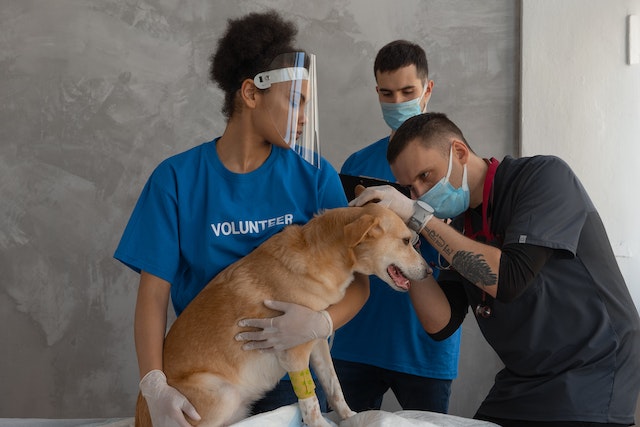10 Best Ways To Keep Fleas Off Dogs [Explained]
![10 Best Ways To Keep Fleas Off Dogs [Explained] Best Ways To Keep Fleas Off Dogs](https://petcreeks.com/wp-content/uploads/2021/04/Best-Ways-To-Keep-Fleas-Off-Dogs.jpg)
Are you tired of watching your furry friend constantly scratch and bite at pesky fleas?
We’ve got good news – there are plenty of effective ways to keep fleas off your dog!
Not only are fleas annoying and uncomfortable for your pup, but they can also lead to more serious health issues.
In this post, we’ll explore some of the best ways to prevent and eliminate fleas for a happy, healthy pup.
So, read through to find out the best ways to keep fleas off dogs.
What are fleas
Fleas are parasitic insects that feed on the blood of animals, including dogs.
They are small, dark brown or reddish-brown in color, and have flat bodies that allow them to move easily through an animal’s fur.
Fleas are a common problem for pet owners, as they can cause skin irritation, hair loss, and other health problems in dogs.
It is important to regularly check your dog for fleas and to take steps to prevent and treat infestations.
This can include using flea combs, flea baths, topical treatments, and other flea control products recommended by your veterinarian.
The Best Ways To Keep Fleas Off Dogs
Here are some common and simple ways to keep fleas off your dog;
1. Regular grooming
Maintaining your dog’s general health and well-being is crucial, and grooming can also help keep fleas at bay.
To get rid of fleas or flea eggs from your dog’s coat, use a flea comb.
Examine your dog’s coat with a broom, paying close attention to the neck, tail, and underside in particular.
This is because fleas frequently gather in these places. The natural oils that can repel fleas can be distributed by brushing your dog’s coat.
2. Use flea and tick-preventive products
There are numerous fleas and tick prevention items on the market, including collars, creams, and pills.
These items can aid in flea repulsion and help keep them from infesting your dog’s coat.
While flea collars are worn around the dog’s neck and can offer protection for several months, topical treatments are given to the dog’s back of the neck.
Once a month, give your dog oral medication to help kill and prevent fleas.
The appropriate preventive product for your dog will depend on their age, weight, and general health, therefore it’s vital to discuss this with your vet.
3. Bathing your dog
Using a flea wash on a regular basis can help kill fleas and keep them from infesting your dog’s coat.
Because conventional dog shampoo might not be effective, make sure to use a flea-killing shampoo.
A dog’s skin can become irritated if flea shampoo is used excessively, so be sure to carefully follow the instructions on the shampoo bottle.
4. Keep your yard clean
Keeping your yard tidy and free of clutter might help lower the likelihood of a flea infestation because fleas can thrive in outside spaces.
Regularly cut the grass, get rid of any heaps of leaves or other junk, and keep the area around your dog’s sleeping space tidy.
To help keep fleas and other pests at bay, think about putting a natural insect repellent spray around your yard.
5. Use flea-repellent plants
Rosemary, mint, and lemongrass are a few herbs that can help keep fleas away.
These plants can help keep fleas off of your dog by being planted in your yard.
By putting them in pots or incorporating them into a homemade flea spray, you may also employ these plants as natural insect deterrents inside your house.
Ultrasonic repellents also work via radio waves. These devices can be worn on a dog’s neck or stomach and will emit a high-pitched sound to try and ‘disable’ fleas, without harming the dog in any way.
6. Keep your dog away from infested areas
Keep your dog away from a flea-infested location if you are aware of it.
This can lessen your dog’s chance of developing a flea infestation.
Make careful to thoroughly inspect your dog’s coat if you think they may have been exposed to fleas and take the necessary precautions to avoid a flea infestation.
7. Use natural remedies
Fleas can be repelled using a number of natural therapies.
Applying essential oils like lavender, lemon, cheap Neem Oil, and peppermint on your dog’s coat will help it stay flea-free.
Apply the essential oil mixture to your dog’s coat by combining a few drops with water.
The essential oils should be carefully diluted because excessive amounts might be harmful to pets.
8. Vacuum regularly
Regular vacuuming might aid in getting rid of any fleas or flea eggs that may be present.
Make sure to vacuum your furniture, bedding, carpets, and rugs.
To stop fleas from reinfesting your home after vacuuming, make sure to dump the vacuum bag or canister in an outdoor trash can.
9. Treat your home
Fleas can reside in carpets, furniture, and bedding, so using a flea fogger or spray to treat your home might help get rid of any fleas that might be present.
Be sure to carefully read and follow the instructions before using any flea treatment in your house, and keep your pets and family members away from the treated area for the advised period of time.
Learn more about dog sick symptoms and how to comfort a sick dog.
10. Cedar Chips
Fleas and ticks totally hate the smell of cedar, and you can get and spread fresh cedar chips around your yard or outdoor area to prevent them from entering your dog’s environment.
The advantage of cedar chips is that they can provide outdoor protection from fleas while you take steps to make your indoor environment safe.
Cedarwood oil can also be effective, and it can be mixed with water and used as a spray, according to dog time.
Read more about How Dogs Get Heartworm: Facts, Symptoms & Prevention.
Dangers of fleas on dogs
Fleas are not only a nuisance for dogs but also pose several dangers to their health.
Here are some common dangers of fleas on dogs:
- Tapeworms: Fleas are the most common carriers of tapeworms in dogs. When a dog ingests fleas while grooming or biting at their skin, it can also ingest tapeworm larvae.
- Bartonellosis: This bacterial infection, also known as cat scratch fever, can be spread by infected fleas. Symptoms of Bartonellosis in dogs include fever, lethargy, and poor appetite.
- Anemia: Fleas feed on a dog’s blood, which can lead to anemia, a condition in which there are not enough red blood cells to carry oxygen throughout the body.
- Allergic reactions: Dogs can be allergic to flea saliva, which can cause severe itching, redness, and swelling of the skin.
- Skin infections: Dogs with flea infestations can develop skin infections due to excessive scratching and biting, which can lead to painful hot spots and hair loss.
- Rocky Mountain Spotted Fever: This bacterial infection can be transmitted to dogs by certain species of fleas. Symptoms include fever, lethargy, swelling of the lymph nodes, and joint pain.
- Plague: While rare, fleas can transmit the plague bacteria to both dogs and humans. Symptoms include fever, chills, weakness, and swollen lymph nodes.
- Cat Scratch Disease: Fleas can also transmit the bacteria that cause Cat Scratch Disease in dogs, which causes fever, loss of appetite, and swollen lymph nodes.
- Staph infections: Flea bites can also cause Staph infections in dogs, leading to pus and inflammation in the affected area.
Learn more about why your dog is pooping liquid blood.
Frequently Asked Questions
What are some effective ways to keep fleas off my dog?
Some effective ways to keep fleas off your dog include regularly grooming your dog with a flea comb, bathing your dog with a flea shampoo, using flea prevention products like spot-on treatments or flea collars, and keeping your dog’s environment clean.
How often should I groom my dog to keep fleas away?
Grooming your dog with a flea comb once or twice a week is recommended to keep fleas away.
This will also help you identify any fleas or flea dirt on your dog early, so you can take action before the infestation gets worse.
Can I use natural remedies to keep fleas off my dog?
There are some natural remedies that can help keep fleas off your dog, such as using essential oils like lavender, cedar, or eucalyptus.
However, it’s important to talk to your veterinarian before using any natural remedies, as some may be harmful to dogs.
How often should I bathe my dog with flea shampoo?
Bathing your dog with flea shampoo once a month is generally recommended to keep fleas away.
However, if your dog has a severe flea infestation, you may need to bathe them more frequently.
Can I prevent fleas without using chemical products?
While chemical flea prevention products like spot-on treatments or flea collars are the most effective way to prevent fleas, there are some natural methods you can use.
These include regularly washing your dog’s bedding, vacuuming your home regularly, and using flea-repelling plants like lavender or mint.
What are the risks of not preventing fleas on my dog?
Not preventing fleas on your dog can lead to a variety of problems, including skin irritation, itching, and even other health issues like tapeworms.
Fleas can also infest your home, making it difficult to get rid of them.
It’s important to take proactive steps to keep fleas off your dog and out of your home.
Learn more about dogs sneezing excessively.
Conclusion
In conclusion, keeping fleas off your furry friend is essential for their health and happiness.
By using a combination of preventative measures such as regular grooming, flea collars, and medication, you can ensure that your dog is protected from these pesky parasites.
Remember to consult with your veterinarian to determine the best course of action for your pet.

![Trauma in Dogs [Signs, Causes & Solutions] Trauma in Dogs](https://petcreeks.com/wp-content/uploads/2023/12/pexels-mikhail-nilov-7469228.jpg)




